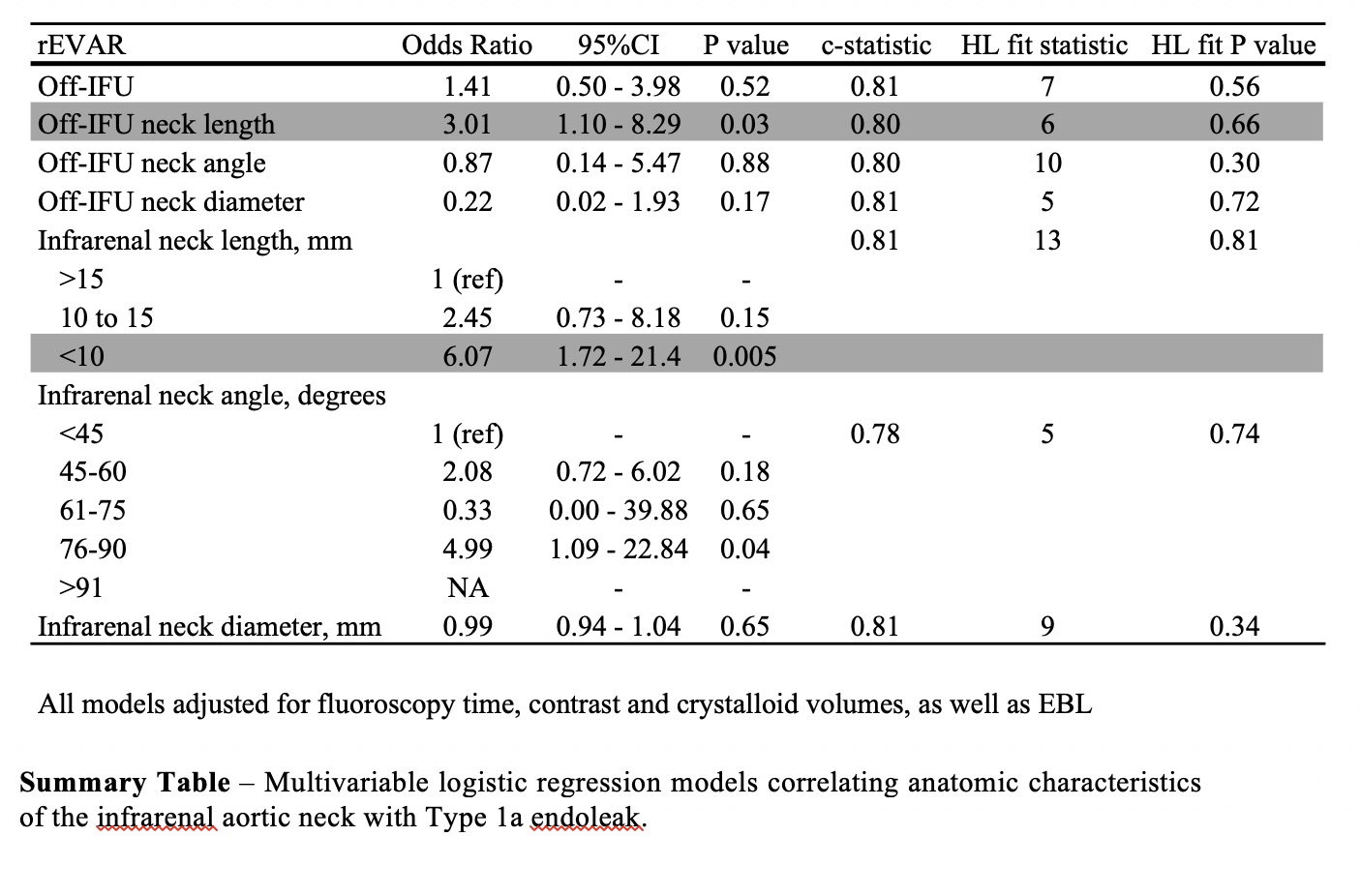Type 1a Endoleak Occurs More Frequently In Patients Treated With Revar Off-ifu And Is Independently Associated With Short Infrarenal Aortic Neck Length
Devin S. Zarkowsky, MD1, Joel L. Ramirez, MD2, Asma Mathlouthi, MD3, Philip P. Goodney, MD MS4, James C. Iannuzzi, MD MPH2, Mahmoud B. Malas, MD MHS5, Rafael D. Malgor, MD1, Caitlin W. Hicks, MD MS6.
1University of Colorado, Aurora, CO, USA, 2University of California San Francisco, San Francisco, CA, USA, 3University of California San Diego, San Diego, CA, USA, 4Dartmouth-Hitchcock Medical Center, Lebanon, NH, USA, 5University of California San Diego, La Jolla, CA, USA, 6The Johns Hopkins Medical Institutions, Baltimore, MD, USA.
OBJECTIVES: Often rAAA patients with marginal anatomy receive endografts. We hypothesized that patients treated with rEVAR on- or off-IFU would demonstrate no difference in Type 1a endoleak frequency.
METHODS: Deidentified data from the VQI EVAR dataset were analyzed. Endograft characteristics recorded in the dataset were correlated with manufacturer specifications and the reported anatomic measurements of the AAA proximal neck, allowing patient treatments to be stratified as adhering to instructions-for-use (IFU) or not. Pre-, intra- and post-operative variables associated with the on- and off-IFU groups were compared with appropriate statistical tests. Multivariable models correlating factors associated with Type 1a endoleak were constructed from those variables significant on univariate analysis.
RESULTS: Between 2013 and 2018, 621 patients with graft, anatomic and outcome data were treated with rEVAR, including 404 (65%) on-IFU and 217(35%) off-IFU. The off-IFU group contained more women (25% vs. 18%, P=0.05) and patients with larger aneurysms (76 vs. 72 mm, P=0.01). All other demographic and pre-operative characteristics were not different between groups. Type 1a endoleaks occurred more frequently in the off-IFU group (6% vs. 2%, P=0.05). Several intraoperative variables were significantly greater in the off-IFU group, including percentage graft oversizing, procedure and fluoroscopy times, contrast and crystalloid volumes, EBL, and intra-operative RBC transfusion (all P<0.05). Infrarenal aortic neck length was shorter in the off-IFU group (P<0.001). One-third of patients in the off-IFU group demonstrated an infrarenal neck angle greater than 61 degrees. No difference existed in the mean aortic neck diameter between groups, however 28% of the off-IFU patients had aortic necks with diameters smaller than lower limit recommended by the graft’s manufacturer, while 24% had necks larger than the corresponding upper limit. A multivariable logistic regression demonstrated no correlation between Type 1a endoleak and the composite off-IFU variable. Additional multivariable models demonstrated neck length off-IFU and neck length <10 mm to be independently associated with Type 1a endoleak (Summary Table).
CONCLUSIONS: Implanting stent grafts off-IFU in rAAA patients leads to more Type 1a endoleaks. Surgeons treating short infrarenal necks should be prepared to deploy proximal extension cuffs, engage in complex branch vessel management or perform an open repair. 
Back to 2020 ePosters
